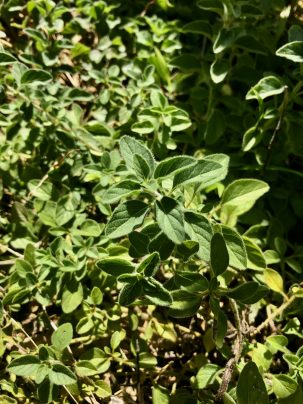
Maui Oregano, photo by Bobbi Misiti
Ingredients
- 7 drops Oregano essential oil
- 7 drops Eucalyptus globulus essential oil
- 8 drops tea tree essential oil
- 15mL (1/2 oz) Coconut oil - melted
- 15mL Sesame oil
Instructions
This recipe makes about a 4% dilution.
Blend together essential oils. Combine carrier oils. Blend together essential oils into carrier oils.
Pour in a one ounce jar with an oil pump or other lid of your choice.
Purchase Pre-made from Bobbi – $15.00 Contact Bobbi to order.
Oregano, Origanum vulgare has potent antibacterial, antifungal, antioxidant, and anti-inflammatory properties. The following about the chemistry of oregano oil is from AARM (Assoc. for the advancement of Restorative Medicine):
The oregano extracts of thymol and carvacrol chemistry have shown significant antioxidant and antimicrobial activity in vitro, leading to the destruction or growth inhibition of a broad spectrum of microorganisms such followed by thymol (an isomer of carvacrol), p-cymene, and γ-terpinene. as Escherichia coli, Staphylococcus aureus (10,11), Listeria innocua and L. monocytogenes, Saccharomyces cerevisiae, Aspergillus niger, Bacillus cereus (12, 13, 14), Bacillus subtilis, Candida albicans, and Eimeria tenella (15,16)
Tea Tree is a powerful anti-septic and has been used by the Australian Aborigines for skin infections. Today tea tree essential oil is used as an antiseptic in skin care products, and in soaps and mouthwashes. The oil is effective against bacterial, fungal and viral infections, and is used in products to treat such conditions as athlete’s foot, warts, acne and vaginal infections, and many skin infections.
Eucalyptus globulus also has a strong anti-bacterial chemistry, as well as anti-septic, anti-viral, anti-fungal activities, and it is anti-inflammatory.
10 Toxicol Mech Methods. 2005;15(4):279–85. Effects of essential oils and monolaurin on Staphylococcus aureus: in vitro and in vivo studies. Preuss H, et al.
11 Braz J Microbiol. 2012;43(3):1120–7. Combination of Origanum vulgare L. essential oil and lactic acid to inhibit Staphylococcus aureus in meat broth and meat model. De Barros J, et al.
12 J Sci Food Agric. 2013;93(11):2707–14. Chemical composition and bioactivity of different oregano (Origanum vulgare) extracts and essential oil. Teixeira B, et al.
13 Nat Prod Res. 2011;25(20):1993–8. Terpenoid composition and antifungal activity of three commercially important essential oils against Aspergillus flavus and Aspergillus niger. Bisht D, et al.
14 Molecules. 2013;18(12):14948–60. Chemical composition and biological activity of essential oils of Origanum vulgare L. subsp. vulgare L. under different growth conditions. De Falco E, et al.
15 J Egypt Soc Parasitol. 2012;42(1):245–50. The efficacy of Origanum vulgare on Eimeria tenella. Toulah F, et al.
16 Medicines (Basel). 2017;4(2). Antibacterial and antifungal activity of essential oils against pathogens responsible for otitis externa in dogs and cats. Ebani V, et al.
